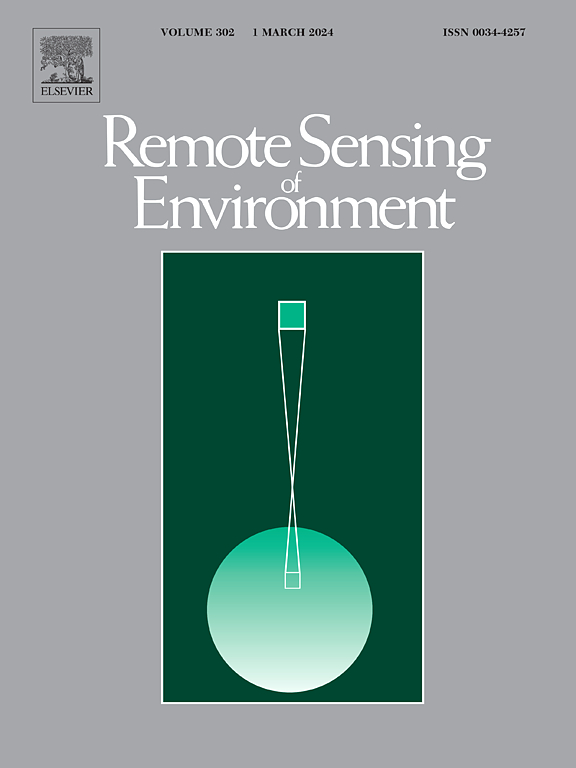Non-uniform climatic responses of land surface phenology derived from optical-, fluorescence-, and microwave-based satellite observations
IF 11.1
1区 地球科学
Q1 ENVIRONMENTAL SCIENCES
引用次数: 0
Abstract
Satellite remote sensing has greatly advanced the study of land surface phenology, providing crucial insights into large-scale vegetation dynamics in the context of climate change. Multi-sensor satellite-derived vegetation proxies, such as the normalized difference vegetation index (NDVI) in optical mode, solar-induced chlorophyll fluorescence (SIF) in fluorescence mode, and vegetation optical depth (VOD) in microwave mode, are effective indicators of vegetation dynamics in greenness, biomass, and productivity. However, a comprehensive understanding of phenological patterns derived from these proxies and their climatic responses remains limited. In this study, spanning 1988–2021, we analyzed spatio-temporal patterns and climatic responses of spring green-up dates (GUDs) and autumn dates of foliar senescence (DFSs) across the three vegetation proxies. We found broadly consistent trends of advancing GUDs (−2.4 to −1.1 days decade−1) across proxies, while DFSs exhibited divergent temporal patterns: VOD-derived DFSs showed significant delays (+1.1 days decade−1), whereas NDVI- and SIF-derived DFSs displayed no clear trends. Rising temperatures were the primary driver of earlier GUDs, while precipitation and insolation had limited influence. In autumn, warming delayed VOD-based DFSs but had minimal effects on NDVI- and SIF-based estimates. Spatial attribution analyses indicated that both biotic and abiotic factors contributed to the spatial variability in climatic responses, with species richness and tree density modulating temperature effects. These findings highlight the importance of proxy selection in phenological studies and underscore the need for integrated investigations into the biophysical mechanisms driving non-uniform climatic responses across vegetation proxies.
基于光学、荧光和微波卫星观测的陆地表面物候的非均匀气候响应
卫星遥感极大地推进了陆地表面物候学的研究,为气候变化背景下的大尺度植被动态提供了重要的见解。光学模式下的归一化植被指数(NDVI)、荧光模式下的太阳诱导叶绿素荧光(SIF)和微波模式下的植被光学深度(VOD)等多传感器卫星衍生植被指标是植被绿度、生物量和生产力动态的有效指标。然而,对这些代用物及其气候响应的物候模式的全面了解仍然有限。本研究以1988-2021年为时间跨度,分析了3个植被代用指标的春青期(GUDs)和秋衰期(dfs)的时空格局和气候响应。我们发现不同代理的gds的推进趋势大致一致(- 2.4至- 1.1天,10年−1),而dfs表现出不同的时间模式:vod衍生的dfs表现出显著的延迟(+1.1天,10年−1),而NDVI和sif衍生的dfs没有明显的趋势。气温上升是早期GUDs的主要驱动因素,而降水和日照的影响有限。在秋季,变暖延迟了基于vod的dfs,但对基于NDVI和sif的估算影响最小。空间归因分析表明,生物因子和非生物因子共同影响了气候响应的空间变异,物种丰富度和树木密度调节了温度效应。这些发现强调了代用物选择在物候研究中的重要性,并强调了对驱动不同植被代用物的非均匀气候响应的生物物理机制进行综合研究的必要性。
本文章由计算机程序翻译,如有差异,请以英文原文为准。
求助全文
约1分钟内获得全文
求助全文
来源期刊

Remote Sensing of Environment
环境科学-成像科学与照相技术
CiteScore
25.10
自引率
8.90%
发文量
455
审稿时长
53 days
期刊介绍:
Remote Sensing of Environment (RSE) serves the Earth observation community by disseminating results on the theory, science, applications, and technology that contribute to advancing the field of remote sensing. With a thoroughly interdisciplinary approach, RSE encompasses terrestrial, oceanic, and atmospheric sensing.
The journal emphasizes biophysical and quantitative approaches to remote sensing at local to global scales, covering a diverse range of applications and techniques.
RSE serves as a vital platform for the exchange of knowledge and advancements in the dynamic field of remote sensing.
 求助内容:
求助内容: 应助结果提醒方式:
应助结果提醒方式:


